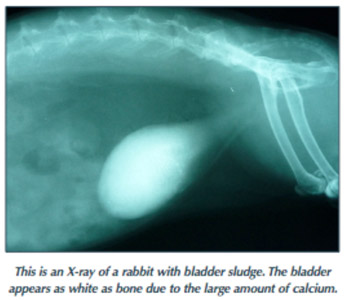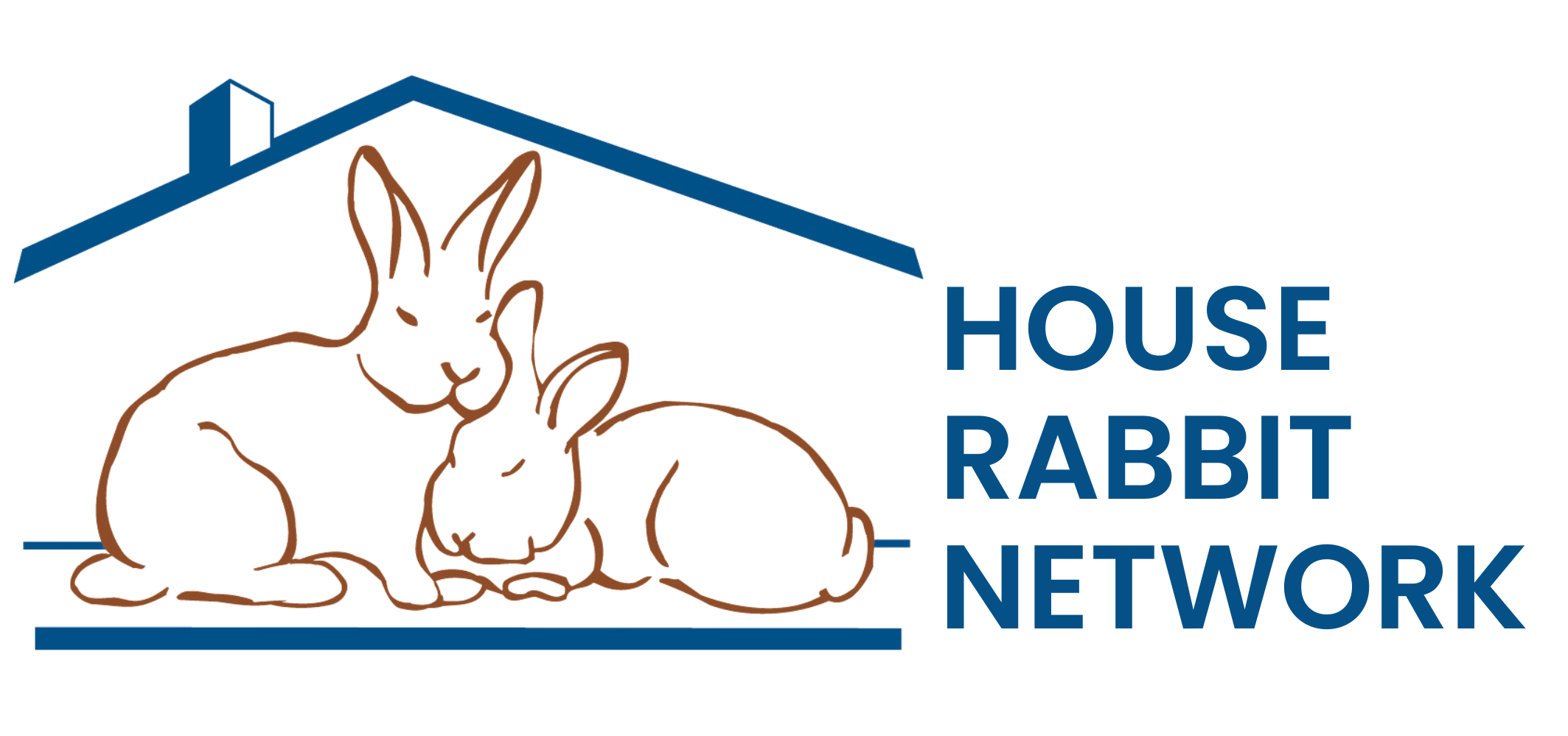Bladder Sludge in Rabbits

Bladder sludge is a condition that affects all ages and breeds of rabbits. It is fairly common but, unfortunately, is difficult to cure. This article will discuss the clinical signs and diagnosis of bladder sludge as well as steps you can take to prevent or manage the condition. Urinary calculi (stones) are a different condition (although likely related) and are treated surgically. Calculi are not discussed in detail in this article.
Causes of Bladder Sludge
It is not entirely clear as to what causes this disorder in rabbits but it is suspected to be related to their unique way of metabolizing calcium. Most animals will absorb from their diets only as much calcium as they currently need; the rest is eliminated through the digestive tract. Rabbits, however, will absorb calcium in proportion to the amount in their diet, regardless of what their body currently requires. They then excrete the excess through the kidneys. It is eliminated in the urine as calcium carbonate crystals, which make normal rabbit urine cloudy. Some rabbits have a syndrome called hypercalcinuria (“bladder sludge”) – they have an overabundance of crystals in their urine. A diet too high in calcium may predispose a rabbit to sludgy urine but it is not the only factor involved. Studies have been performed in which rabbits were fed enormous amounts of calcium long-term and bladder sludge was not induced. Other contributing factors may be genetics, decreased water intake, underlying urinary tract conditions, and less frequent urination. Anything that prevents a rabbit from posturing normally to urinate will likely result in longer retention of urine and larger amounts of crystal buildup. Arthritis in the spine or hips, sore hocks, and obesity are some such conditions.
Signs of Bladder Sludge
Often the first sign noted in a rabbit affected with bladder sludge is abnormal urine. The color of normal urine can range from very light yellow to rust colored, which is caused by normal pigments called porphyrins. It can appear almost sandy when dry. In a rabbit with bladder sludge, the urine is extremely thick and pasty and tends to accumulate on the fur (unlike normal urine). As it dries, a very large amount of gray-white chalky material will be left behind. Because the urine is so thick and difficult to pass, rabbits will often strain while urinating and may only be able to pass a small amount. They may have a poor appetite, grind their teeth, or sit in a hunched posture as a result of pain. Urination may occur more frequently than usual or in inappropriate areas outside the litter box. Sometimes rabbits will even involuntarily dribble urine. The skin on the inner thighs and belly can become reddened and sore from constant contact with urine (urine scald). If the bladder is infected or severely inflamed, blood can be present in the urine. Since normal urine can be reddish in color, it is important to differentiate this from actual blood. This can be done with a urine dipstick or by microscopic examination of the urine sediment.
Diagnosis
Sometimes the description of the signs and a physical examination are all that is needed to diagnosis bladder sludge. Nevertheless, radiographs (X-rays) are almost always performed to confirm the condition and evaluate the size of the bladder and amount of sludge remaining. Radiographs will also reveal if there are any calculi within the urinary tract and can show additional abnormalities in the chest, abdomen, and skeleton. Urinalysis is essential to determine if there is an infection and to search for any abnormal cells in the urine. A culture and sensitivity may be indicated to identify the type of bacteria causing the infection. If a culture is done, a sterile sample needs to be obtained directly from the bladder, usually via cystocentesis, to avoid any contamination from the urethra or the litter box. This is done by gently grasping the bladder through the abdomen and inserting a small needle attached to a syringe through the skin into the bladder. Suction is applied and the urine is collected in the syringe. Cystocentesis is a very quick procedure and can be performed while the rabbit is awake with little discomfort to the rabbit. If an infection is present, it is usually secondary to the sludge problem and not the cause of the condition. Bloodwork may be performed to check the calcium level as well as look for signs of infection. It is always a good idea to check the kidney and liver enzymes to see if there are any underlying conditions that could have contributed to the development of bladder sludge. If treatment requires anesthesia, existing health problems that may complicate anesthesia should also be identified.
Immediate Treatment
Since rabbits are rarely able to empty a bladder full of sludgy urine on their own and are often in pain, they are usually anesthetized for treatment. The bladder may be emptied manually with gentle pressure or may be emptied through a urinary catheter. A soft rubber catheter is placed through the urethra into the bladder and saline is flushed through to dilute and thin out the sludge. The material is suctioned out with a syringe and the process repeated until the urine runs clear. A urine sample can be collected at this time if it hasn’t been done already. Once the bladder has been flushed, it is important to keep the urine dilute after the rabbit wakes up. If the rabbit is very dehydrated, an IV catheter can be placed for fluid therapy while hospitalized. Fluids can also be given subcutaneously (under the skin) either at the hospital or by the owner at home. Pain/anti-inflammatory medication is crucial, especially post-catheterization since the bladder will be sore after manipulation. If there is a bacterial infection, antibiotics will be prescribed.
Treatment/Prevention
Once at home, the rabbit’s water intake should be increased by offering plenty of fresh leafy greens or by flavoring the drinking water with a small amount of natural fruit juice (with no sugar added). The diet should be modified to contain less calcium. Alfalfa hay and alfalfa-based pellets should be discontinued and replaced with grass hay such as timothy. Pelleted diets should be fed in limited amounts, if at all. Vegetables are an important part of a rabbit’s diet since they are nutritious and contain a large percentage of water. However, the frequency and amount of high-calcium vegetables such as kale, turnip greens, and parsley should be decreased and replaced with those lower in calcium such as carrot tops, endive, and collard greens. Dandelion greens are one exception; they have a high amount of calcium but also may act as a diuretic thus increasing urine production. No additional mineral supplements should be given. Cranberry and vitamin C supplements are thought to aid in healing of the urinary tract and, in humans, prevent bacteria from adhering to the bladder lining. There has not yet been any research on these supplements in rabbits but they may help. Again, avoid juices or tablets with added sugar. Exercise should be encouraged to stir up the bladder sludge and keep it from settling. Rabbits that move around more will also consume more water and therefore urinate more frequently, giving the sludge less time to accumulate.
Frequent examinations are recommended to monitor response to treatment and resolution of any skin/urinary tract infections. Sludge will often recur even if all the recommended steps are taken. The main goals are to keep your rabbit happy and comfortable and to try to manage the condition as well as possible. Hopefully, as more research is done, we will learn more about this syndrome and how best to manage it.
©2009 Victoria A. Papscoe, DVM
